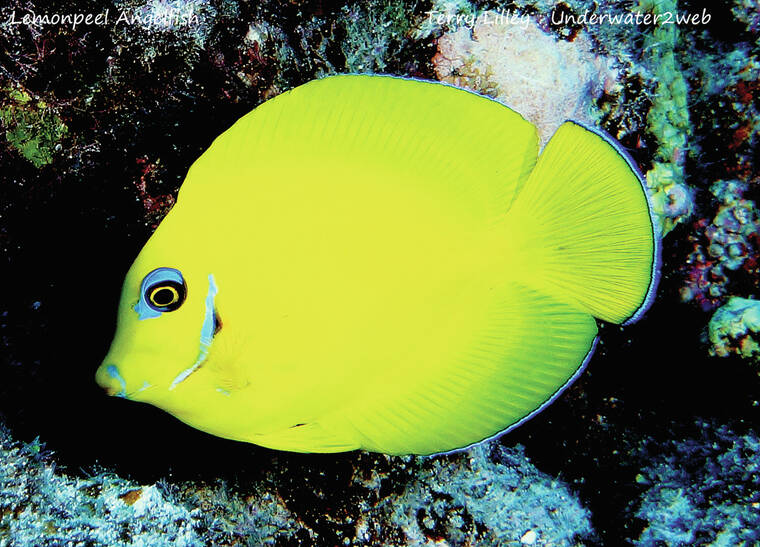I was out scuba diving in Kaneohe Bay recently shooting a video of the corals, when I noticed a very pretty yellow fish back in a cave. It did not look like a butterfly fish or a yellow tang due to its shape and when I got closer and turned on my bright lights I noticed a bright blue circle around its eyes.
I was amazed that I found a fish species here in Hawai‘i that I have never seen before, but something in my mind told me it was out of place. Over the past 20 years, I have video and pictures of almost every known fish and coral species here in Hawai‘i, but that is actually not too unusual because we have very few marine life species compared to other islands in the Pacific Ocean. Hawai‘i is so isolated, we are considered a desert underwater compared to the rest of the Pacific. We only have around 25 coral species in all of the Hawaiian Islands, whereas the Philippines has more than 1,000 coral species.
When I got back home and looked at my video footage, I knew exactly what the fish was I saw in Kaneohe Bay. It was a lemonpeel angelfish. I have seen quite a few of these fish in the Philippines, but have never heard of one living in Hawaiian waters. The first thing I wondered was, how did this fish come to be living in O‘ahu more than 2,000 miles away from its known habitat. I discussed my unusual find with some other marine biologist and we have some theories about how a lemonpeel angelfish came to be living in Kaneohe Bay.
The first theory is that someone let it go out of their aquarium. After doing some research, I read an old news article about a boatload of non-native aquarium fish sunk years ago near Kaneohe Bay. Maybe this fish was the offspring of the release of hundreds of tropical fish years ago. The other theory is lemonpeel angelfish babies may have floated on currents and ended up in Hawai‘i. I am sure most of the fish species that are native to Hawai‘i ended up here that way millions of years ago, so I am sure it can happen again.
A few weeks ago at ‘Anini Beach, a team of scientists and myself documented a very strange anemone-like creature growing in about 2-foot deep of water. When I took some close up video, I recognized it as a non-native leather coral that has never before been seen in Hawai‘i, but is common in the South Pacific. There have been other incidents lately where unusual marine life species show up in Hawaiian waters.
NOAA has been tracking current changes in Hawai‘i for years that are being caused by the change in temperatures in far northern regions of our planet. Rising sea temperatures caused by melting ice are changing our currents in Hawai‘i and also changing our wind patterns. With the changing currents there may be new marine life species making it to Hawai‘i from other Pacific Islands.
Will we see a colony of beautiful lemonpeel angelfish living in Hawai‘i someday soon? Who knows, but it is a good time for divers and snorkelers to be on the lookout for new and unusual species in Hawai‘i. If these new immigrants are coming here on their own, then that would be part of a natural evolution. But if they are arriving with the help of people, then we may eventually have an outbreak of invasive species that could upset the balance of our current marine life, like what happened in the 1950s when the government introduced roi (peacock grouper) into Hawai‘i from Tahiti.
It is a good time to be on the lookout for new marine life arrivals and if you see anything unusual try to get a picture of it, and email it to me at underwater2web@gmail.com so I can do an identification. Our environment is changing so it is good to study the changes the best we can to better manage our marine resources in the future.
•••
Terry Lilley is a marine biologist living in Hanalei Kaua‘i and co-founder of Reef Guardians Hawai‘i, a nonprofit on a mission to provide education and resources to protect the coral reef. To donate to Reef Guardians Hawaii go to www.reefguardianshawaii.org.


